|
|
SI5351Silicom labs
|
x 1 | |
|
|
Arduino pro microArduino
|
x 1 | |
|
|
Display oled sh1106Display oled
|
x 1 |
Exploring the potential of the SI5351 module in electronic projects
In this tutorial, you will dive into the depths of this amazing device and discover its limitless potential in signal and frequency generation.
Join me as we explore all the functions and features of the SI5351 module, from its ability to generate multiple frequencies with amazing precision to its versatility in applications such as frequency synthesizers, software-defined radios, and communication projects.
Whether you are a beginner or a subject matter expert, this comprehensive guide will provide you with the knowledge to master the SI5351 module. You will learn how to configure it, control it through an arduino and take full advantage of its capabilities.
It doesn’t matter if you are interested in electronics, hobby radio or just exploring new technologies, this video will show you how the SI5351 module can supercharge your projects and take your creativity to the next level.
Get ready to immerse yourself in an exciting journey of discovery and learning. Don’t miss this opportunity to unlock the full potential of the SI5351 module!
Electronic components
Arduino Pro Micro
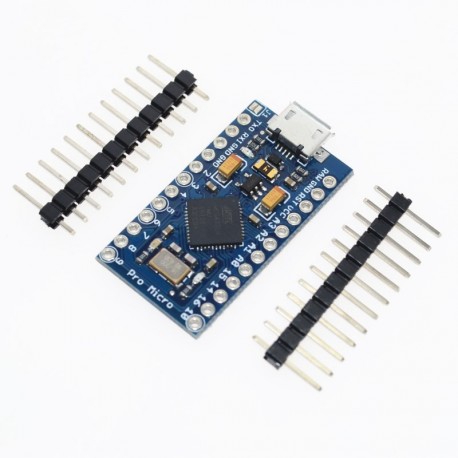
The Pro Micro is similar to the arduino Mini Pro except with an ATMEGA32U4 on board. This chip makes a big difference since it can also be used as a human interface device. The USB transceiver inside the 32U4 allows us to add USB connectivity on board and do away with bulky external USB interface. This little board does all the Arduino functions you are familiar with: 4 channel 10-bit ADC, 5 PWM pins, 12 DIOs, as well as hardware serial Rx and Tx connections. Running at 16 MHz and 5 V. This little microcontroller can go anywhere. There is a voltage regulator on board so that it can accept a voltage of up to 12V.
12 digital I/O pins (5 PWM)
4 analog input pins (10 bit each)
Input voltage 5-12V (It has an internal regulator)
Output voltage: 5v
Maximum total output current 150mA
ATMega 32U4 running at 5V/16MHz
Supported under Arduino IDE v1.0.1
Micro-USB connector for programming
4 pines x ADC de 10 bits
Rx and Tx Hardware Serial Connections
12 digital inputs/outputs of which 5 can be PWM.
Dimensions: 3.31cm X 1.78cm
SI5351 module
PinOut

VCC: Power pin. It must receive a 3.3V or 5V power supply, depending on the module specification.
GND: Ground pin. It must be connected to the ground terminal of the system or power supply.
SDA: Bidirectional data line for I2C (Inter-Integrated Circuit) communication. This pin is used to send and receive data to and from the SI5351 module.
SCL: Clock line for I2C communication. This pin provides the clock pulse to synchronize data transmission between the master device and the SI5351 module.
CLK0, CLK1, CLK2: These pins are configurable clock signal outputs from the SI5351 module. You can use them to generate different frequencies and waveforms according to your needs.
MS0, MS1, MS2: These pins are register bank select pins for the SI5351 module configuration. They set the register bank that the I2C bus accesses.
The Si5351 is a Programmable Frequency Clock (PLL) generator produced by Silicon Labs. It is widely used in electronic projects and Radio Frequency (RF) applications, such as building oscillators, frequency synthesizers, software-defined radios (SDR) and other projects that require a highly accurate and stable signal source.
The Si5351 has the ability to generate three independent clock signals with frequencies ranging from a few kilohertz to a few hundred megahertz, making it suitable for a wide range of applications. In addition, it is programmable through an I2C communication interface, allowing designers to easily adjust the frequency and phase of the output signal accurately and quickly.
Clock Generator Si5351a – 8 Khz to 160 Mhz + 3 SMA female connectors
This module has a precision 25 MHz crystal reference and an internal PLL and dividers, so it can output almost any frequency from <8 KHz to over 160 MHz. The Si5351A Clock Generator is an I2C clock generator. It uses the onboard precision clock to control multiple PLLs and clock dividers using I2C instructions. By configuring the PLL and dividers you can create precise and arbitrary frequencies. There are three independent outputs, and each one can have a different frequency. Outputs are 3Vpp, either via a breadboard compatible header or for RF work, an optional SMA connector. We put this handy little chip on its own PCB, with a 3.3V LDO regulator so it can be powered from 3-5VDC.
SMA Female Jack Connector To PCB Straight RF Adapter
– Series: SMA
– Gender: Female
– Type: outer screw inner hole
– Impedance: 50 Ohm
– Frequency: 0~6GHz
– Connector material: copper
– Length: 13mm
– Stitch length: 4mm
Applications
HDTV, DVD/Blu-ray, cable box
Audio/video equipment, games
Printers, scanners, projectors
portable instrumentation
residential gateways
networks/communication
servers, storage
XO Replacement
female pins

Display oled sh1106
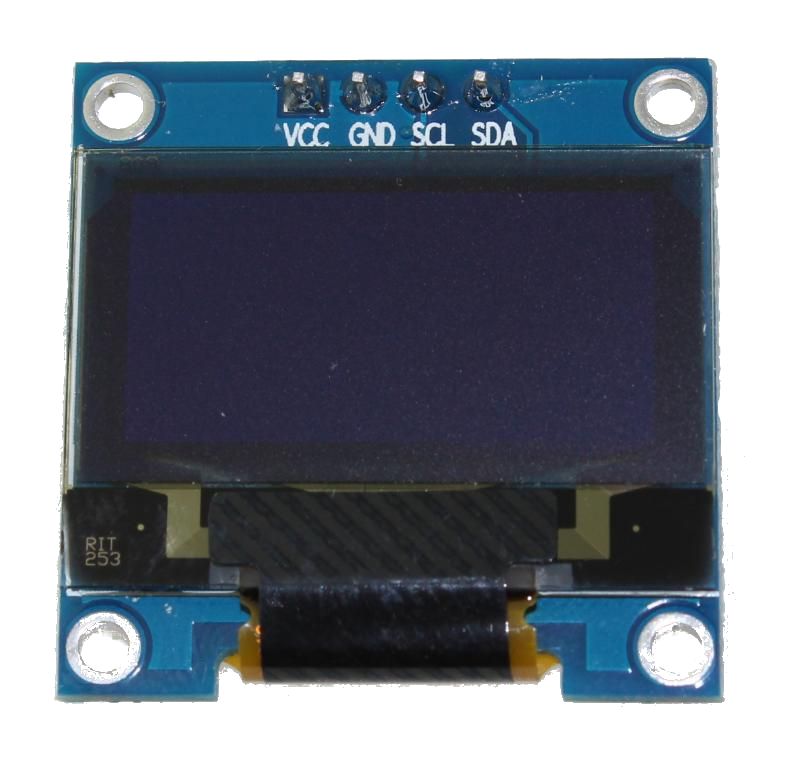
It is a 128×64 dot monochrome OLED screen module with I2C interface. It has several advantages compared to LCD screens, and we can highlight its high brightness, very good contrast, a wider viewing angle, and low consumption. of energy. It is compatible with Arduino Rasberry Pi and PIC microcontrollers among others. It works with logic levels from 3.3V to 5V and has a viewing angle greater than 160 degrees. Screen Size is 1.3 inches. It is powered with a voltage of 3.3V to 5V. It can be used in applications such as smart watches, MP3, thermometers, instruments, and various projects, etc.
Characteristics
Interface: I2C(3.3V / 5V logic level)
Resolution: 128 x 64
Angle of view: >160 degree
Display color: Blue
Display size: 1.3 inch
Driver IC: SH1106
Power supply: DC 3.3V~5V
Operating temperature: -20~70’C
Application: smart watch, MP3, thermometer, instruments, DIY projects, etc.
17 buttons
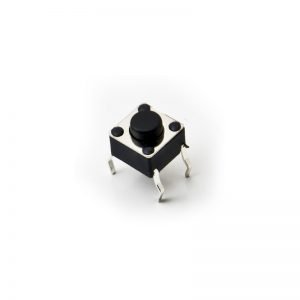
A socket for arduino pro micro
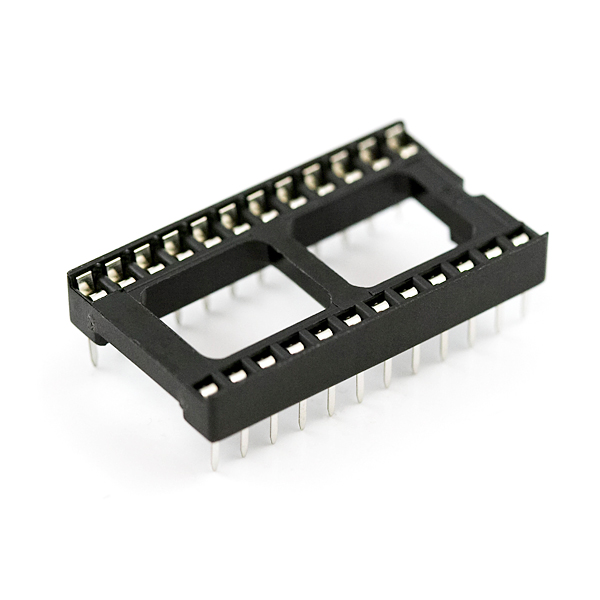
electronic diagram
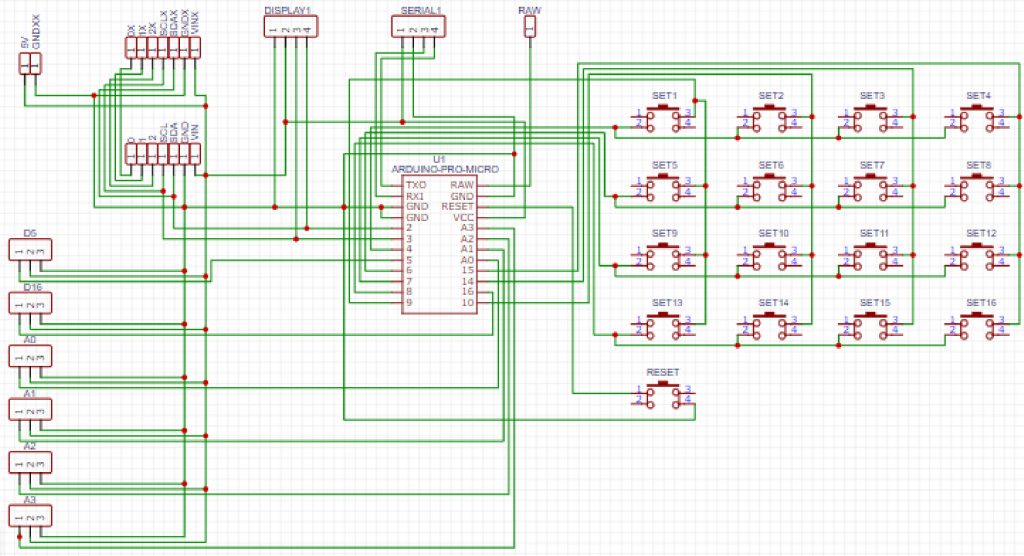
PCB
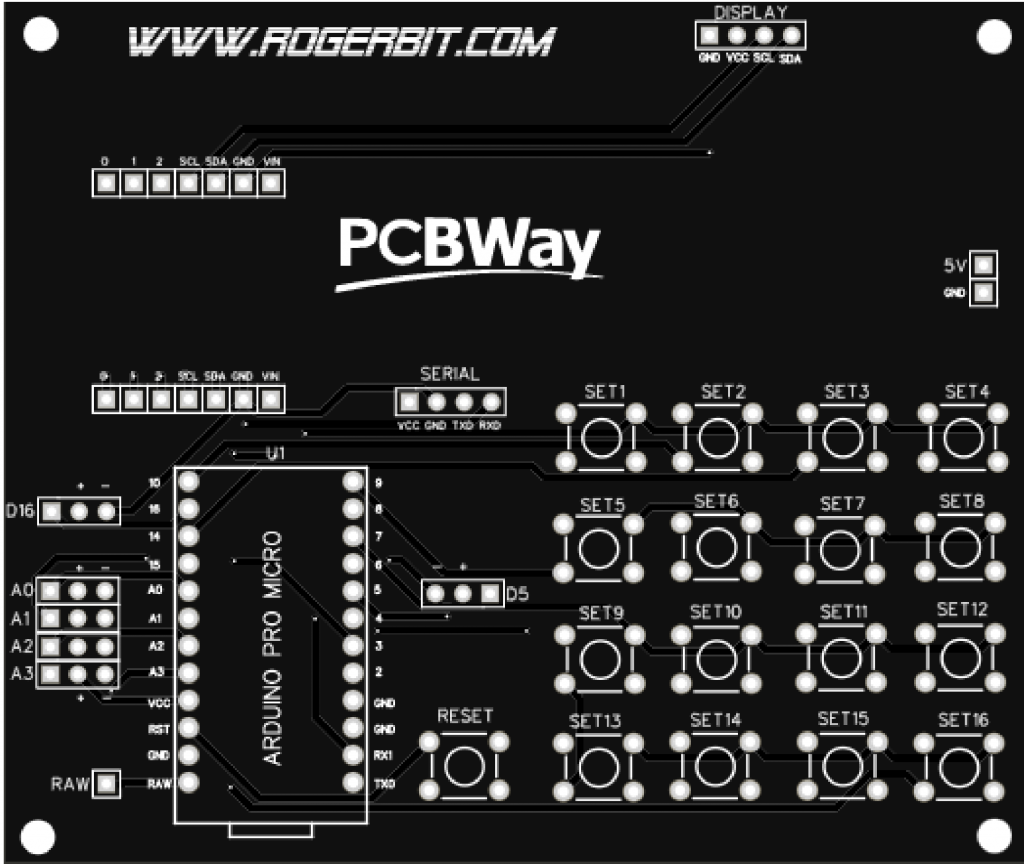
Source code
Download in https://rogerbit.com/wprb/2023/05/si5351/
Exploring the potential of the SI5351 module in electronic projects
*PCBWay community is a sharing platform. We are not responsible for any design issues and parameter issues (board thickness, surface finish, etc.) you choose.
- Comments(0)
- Likes(2)
-
 CarlosVolt Tutoriales
Sep 12,2023
CarlosVolt Tutoriales
Sep 12,2023
-
 GabrielGarcia
Jun 24,2023
GabrielGarcia
Jun 24,2023
- 0 USER VOTES
- YOUR VOTE 0.00 0.00
- 1
- 2
- 3
- 4
- 5
- 6
- 7
- 8
- 9
- 10
- 1
- 2
- 3
- 4
- 5
- 6
- 7
- 8
- 9
- 10
- 1
- 2
- 3
- 4
- 5
- 6
- 7
- 8
- 9
- 10
- 1
- 2
- 3
- 4
- 5
- 6
- 7
- 8
- 9
- 10
 More by CarlosVolt Tutoriales
More by CarlosVolt Tutoriales
-
 Infrared stepper motor control with speed control
More info and updates https://rogerbit.com/wprb/2024/09/motor-paso-a-paso-x-infrarrojo/In this proje...
Infrared stepper motor control with speed control
More info and updates https://rogerbit.com/wprb/2024/09/motor-paso-a-paso-x-infrarrojo/In this proje...
-
 Uploading BME280 Sensor Data to ThingSpeak Using ESP32
In this tutorial, we will show you how to connect a BME280 sensor to an ESP32 to read temperature, h...
Uploading BME280 Sensor Data to ThingSpeak Using ESP32
In this tutorial, we will show you how to connect a BME280 sensor to an ESP32 to read temperature, h...
-
 Water pump control for irrigation via telegram and esp32
Water Pump Control by Telegram and ESP32 is an automated system that allows you to remotely control ...
Water pump control for irrigation via telegram and esp32
Water Pump Control by Telegram and ESP32 is an automated system that allows you to remotely control ...
-
 Air conditioning on/off control via telegram and esp32
In this tutorial we will see how to control an air conditioner, with an esp32 and the telegram appli...
Air conditioning on/off control via telegram and esp32
In this tutorial we will see how to control an air conditioner, with an esp32 and the telegram appli...
-
 35 watt stereo amplifier
In this video we will see how to build an audio amplifier, with the TDA7377 integrated circuit, and ...
35 watt stereo amplifier
In this video we will see how to build an audio amplifier, with the TDA7377 integrated circuit, and ...
-
 Laser alarm with RFID module
More info and updates in https://rogerbit.com/wprb/2024/08/alarma-laser-rfid/In this project, we bui...
Laser alarm with RFID module
More info and updates in https://rogerbit.com/wprb/2024/08/alarma-laser-rfid/In this project, we bui...
-
 Control lights by voice commands and keys
In this tutorial we will see how to create a device to control lights by voice commands, with a modu...
Control lights by voice commands and keys
In this tutorial we will see how to create a device to control lights by voice commands, with a modu...
-
 Stepper motor control x bluetooth and app
In this tutorial we will see a circuit, which controls a stepper motor, with an application made in ...
Stepper motor control x bluetooth and app
In this tutorial we will see a circuit, which controls a stepper motor, with an application made in ...
-
 DFplayermini x bluetooth mp3 player control
More info and updates in https://rogerbit.com/wprb/2022/12/dfplayermini-x-bluetooth/In this tutorial...
DFplayermini x bluetooth mp3 player control
More info and updates in https://rogerbit.com/wprb/2022/12/dfplayermini-x-bluetooth/In this tutorial...
-
 Robot with WiFi control and servos driven by ESP32
More info and updates in https://rogerbit.com/wprb/2023/07/robot-wifi/A robot controlled by Wi-Fi, s...
Robot with WiFi control and servos driven by ESP32
More info and updates in https://rogerbit.com/wprb/2023/07/robot-wifi/A robot controlled by Wi-Fi, s...
-
 How to make a water level meter with uln2803
In this tutorial we will see how to make a water level meter circuit with the built-in uln2803.The p...
How to make a water level meter with uln2803
In this tutorial we will see how to make a water level meter circuit with the built-in uln2803.The p...
-
 Color Detector with Arduino and OLED display
In this tutorial we will show you how to build a color detector using the TCS3200 sensor and an SH11...
Color Detector with Arduino and OLED display
In this tutorial we will show you how to build a color detector using the TCS3200 sensor and an SH11...
-
 DTMF decoder for handy with arduino, control over several kilometers
In this tutorial we will see how to make a circuit to connect to our handy, in this case a Baofeng U...
DTMF decoder for handy with arduino, control over several kilometers
In this tutorial we will see how to make a circuit to connect to our handy, in this case a Baofeng U...
-
 Turn on light from thindspeak with esp32
In this tutorial, we will show you how to control lights over the Internet using an ESP32 and the Th...
Turn on light from thindspeak with esp32
In this tutorial, we will show you how to control lights over the Internet using an ESP32 and the Th...
-
 MP3 player control with webserver using ESP32 WIFI
In this tutorial, you will learn how to build a web server using the ESP32 to control the YX5300 mod...
MP3 player control with webserver using ESP32 WIFI
In this tutorial, you will learn how to build a web server using the ESP32 to control the YX5300 mod...
-
 Time clock with fingerprint IoT module, uploading data to thingspeak
More info in and updates in https://rogerbit.com/wprb/2022/07/reloj-de-control-fingerprint/In this t...
Time clock with fingerprint IoT module, uploading data to thingspeak
More info in and updates in https://rogerbit.com/wprb/2022/07/reloj-de-control-fingerprint/In this t...
-
 Make your own logic tip (includes printed circuit board)
In this video tutorial we will see how to make a logic tip, on a printed circuit, with the integrate...
Make your own logic tip (includes printed circuit board)
In this video tutorial we will see how to make a logic tip, on a printed circuit, with the integrate...
-
 Coil or inductor meter with Arduino and OLED display
More info and updates in https://rogerbit.com/wprb/2022/06/medidor-inductores/In this tutorial we wi...
Coil or inductor meter with Arduino and OLED display
More info and updates in https://rogerbit.com/wprb/2022/06/medidor-inductores/In this tutorial we wi...
-
-
AEL-2011 Power Supply Module
555 0 2 -
AEL-2011 50W Power Amplifier
514 0 2 -
-
-
Custom Mechanical Keyboard
710 0 0 -
Tester for Touch Screen Digitizer without using microcontroller
340 2 2 -
Audio reactive glow LED wristband/bracelet with NFC / RFID-Tags
322 0 1 -
-
-














































